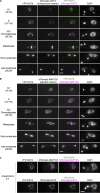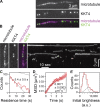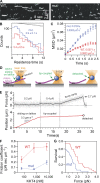The kinetoplastid kinetochore protein KKT4 is an unconventional microtubule tip-coupling protein
- PMID: 30209069
- PMCID: PMC6219724
- DOI: 10.1083/jcb.201711181
The kinetoplastid kinetochore protein KKT4 is an unconventional microtubule tip-coupling protein
Abstract
Kinetochores are multiprotein machines that drive chromosome segregation by maintaining persistent, load-bearing linkages between chromosomes and dynamic microtubule tips. Kinetochores in commonly studied eukaryotes bind microtubules through widely conserved components like the Ndc80 complex. However, in evolutionarily divergent kinetoplastid species such as Trypanosoma brucei, which causes sleeping sickness, the kinetochores assemble from a unique set of proteins lacking homology to any known microtubule-binding domains. Here, we show that the T. brucei kinetochore protein KKT4 binds directly to microtubules and maintains load-bearing attachments to both growing and shortening microtubule tips. The protein localizes both to kinetochores and to spindle microtubules in vivo, and its depletion causes defects in chromosome segregation. We define a microtubule-binding domain within KKT4 and identify several charged residues important for its microtubule-binding activity. Thus, despite its lack of significant similarity to other known microtubule-binding proteins, KKT4 has key functions required for driving chromosome segregation. We propose that it represents a primary element of the kinetochore-microtubule interface in kinetoplastids.
© 2018 Llauró et al.
Figures









Similar articles
-
1H, 13C and 15N resonance assignments for the microtubule-binding domain of the kinetoplastid kinetochore protein KKT4 from Trypanosoma brucei.Biomol NMR Assign. 2020 Oct;14(2):309-315. doi: 10.1007/s12104-020-09968-1. Epub 2020 Jul 21. Biomol NMR Assign. 2020. PMID: 32696260 Free PMC article.
-
Structural characterization of KKT4, an unconventional microtubule-binding kinetochore protein.Structure. 2021 Sep 2;29(9):1014-1028.e8. doi: 10.1016/j.str.2021.04.004. Epub 2021 Apr 28. Structure. 2021. PMID: 33915106 Free PMC article.
-
Faithful chromosome segregation in Trypanosoma brucei requires a cohort of divergent spindle-associated proteins with distinct functions.Nucleic Acids Res. 2018 Sep 19;46(16):8216-8231. doi: 10.1093/nar/gky557. Nucleic Acids Res. 2018. PMID: 29931198 Free PMC article.
-
The unconventional kinetoplastid kinetochore: from discovery toward functional understanding.Biochem Soc Trans. 2016 Oct 15;44(5):1201-1217. doi: 10.1042/BST20160112. Biochem Soc Trans. 2016. PMID: 27911702 Free PMC article. Review.
-
Evolutionary cell biology of chromosome segregation: insights from trypanosomes.Open Biol. 2013 May 1;3(5):130023. doi: 10.1098/rsob.130023. Open Biol. 2013. PMID: 23635522 Free PMC article. Review.
Cited by
-
1H, 13C and 15N resonance assignments for the microtubule-binding domain of the kinetoplastid kinetochore protein KKT4 from Trypanosoma brucei.Biomol NMR Assign. 2020 Oct;14(2):309-315. doi: 10.1007/s12104-020-09968-1. Epub 2020 Jul 21. Biomol NMR Assign. 2020. PMID: 32696260 Free PMC article.
-
CLK1/CLK2-driven signalling at the Leishmania kinetochore is captured by spatially referenced proximity phosphoproteomics.Commun Biol. 2022 Nov 28;5(1):1305. doi: 10.1038/s42003-022-04280-1. Commun Biol. 2022. PMID: 36437406 Free PMC article.
-
Divergent polo boxes in KKT2 bind KKT1 to initiate the kinetochore assembly cascade in Trypanosoma brucei.Mol Biol Cell. 2022 Dec 1;33(14):ar143. doi: 10.1091/mbc.E22-07-0269-T. Epub 2022 Sep 21. Mol Biol Cell. 2022. PMID: 36129769 Free PMC article.
-
Diverse mechanisms of centromere specification.Curr Biol. 2021 Nov 22;31(22):R1491-R1504. doi: 10.1016/j.cub.2021.09.083. Curr Biol. 2021. PMID: 34813757 Free PMC article. Review.
-
A CLK1-KKT2 Signaling Pathway Regulating Kinetochore Assembly in Trypanosoma brucei.mBio. 2021 Jun 29;12(3):e0068721. doi: 10.1128/mBio.00687-21. Epub 2021 Jun 15. mBio. 2021. PMID: 34128702 Free PMC article.
References
Publication types
MeSH terms
Substances
Grants and funding
LinkOut - more resources
Full Text Sources
Other Literature Sources

